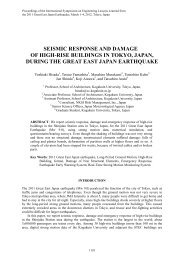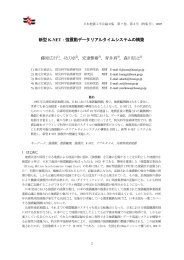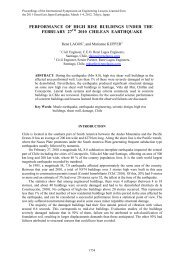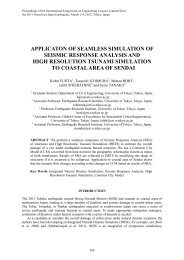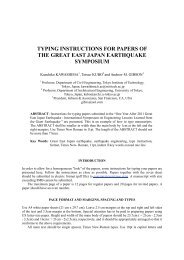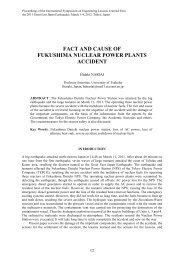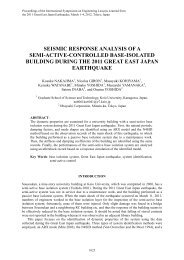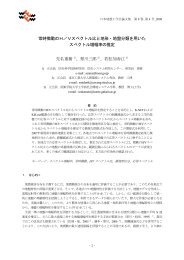2. - 日本地震工学会
2. - 日本地震工学会
2. - 日本地震工学会
Create successful ePaper yourself
Turn your PDF publications into a flip-book with our unique Google optimized e-Paper software.
E E V tke V t u st22u d u 1 ⎛du⎞Ek = ∫ ρV 0s t du = ρV 2s t⎜ ⎟ dt 2 ⎝ dt ⎠E eGt2γ 1 2 1 ⎛du⎞e = ∫0s τ γ = s γ = ρ s ⎜ ⎟E V t d V tG V t2 2 ⎝ dt ⎠ (2) EEk2⎛du⎞E = Ek+ Ee= ρVs t⎜ ⎟e ⎝ dt ⎠s2
E t = dE dtSeismograghLayer No.GroundAsurface2h⎛du⎞EdE dt = ρVs⎜ ⎟ s E 11sh⎝ dt ⎠ 22Surfacelayer BE A m B m mh2E E mt2⎛dE⎞t2⎛du⎞u dE = ∫ dt = ρt⎜ ⎟ Vs dt1 ⎝ dt∫ ⎠t⎜ ⎟1 ⎝ dt ⎠ CA nn B n EE dz uBase layer u zi( ω t+kz) i(ωt−kz)u = Ae + Be 2 2 t ω A,B k k = ρω G*ρ G *G * D D G* = G( 1+ 2iD) A , B A B m mm+ 1 , m+1 ⎡ * * * *km 1Gm 1 kmGm ikmhkm m 1Gm 1 kmG⎤+ + + + + − m −ikmhmee* *⎧Am+ 1⎫ ⎢2km 1Gm 1 2km 1G⎥⎪ ⎪ + + + m+1⎧ ⎪Am⎫⎪⎧Am⎡T⎤= = ⎪⎨ ⎬ ⎨ ⎬* * * *m 1Bm 1 k B ⎣ + ⎦⎨⎪⎩ + ⎪⎭ m 1Gm 1 kmGm ikmhkm m 1Gm 1 kmGmik m B+ + − + +−mmh⎪⎩ ⎪⎭mee⎪⎩⎢* *2km+ 1Gm+ 1 2km+ 1G⎥m+1⎢⎣+ ⎥⎦⎫⎪⎬⎪⎭3
h u u m n ziωtiωtum = Ume = ( Am + Bm)e iωtiωtun = Une = ( An + Bn)e⎡T⎤⎣ m+1 ⎦ ⎧ ⎪An⎫ ⎪⎧ Am AmT11 T12m[ Tn][ Tn 1]T ⎪⎫ ⎪⎧ − m+ 1 T ⎪⎫ ⎪⎡ ⎤⎧ ⎪A⎫⎨ ⎬= … ⎡ ⎤ = ⎡ ⎤n, m+1 =⎪B ⎣ ⎦⎨ ⎬nB ⎣ ⎦⎨ ⎬ ⎨mB ⎢T 21 T ⎥⎬ ⎩ ⎪ ⎭ ⎪ ⎩ ⎪ ⎭ ⎪ ⎩ ⎪ m⎭ ⎪ ⎣ 22 ⎦⎩ ⎪Bm⎭⎪ ⎡ ⎤⎣Tnm , + 1⎦= [ Tn][ Tn− 1]… ⎡T⎤⎣ m+1⎦2× 2 T11, T12, ⋅⋅ U , U mn⎧ ⎪Un⎫ ⎪⎡T11 + T21 T12 + T22⎤⎧ ⎪Am⎫ ⎪⎧ AmP ⎪ ⎪⎫⎨ ⎬= ⎨ ⎬=⎡ ⎤nm , + 1Um1 1 B ⎣ ⎦⎨ ⎬⎪⎢⎥⎩ ⎪⎭ ⎣⎦⎪⎩ m⎪⎭ ⎪⎩Bm⎪⎭⎧ ⎪Am⎫ ⎪−1⎧ Un An1 UnP ⎪⎫ ⎪⎧ nm , 1 , ⎪⎫ ⎪− ⎧ ⎫+ Tnm , + 1 P ⎪ ⎪⎨ ⎬= ⎡ ⎤ ⎡ ⎤⎡ ⎤nm , + 1 ⎬B ⎣ ⎦ ⎨ ⎬ ⎨ ⎬=m Um B ⎣ ⎦⎣ ⎦ ⎨ ⎪⎩ ⎪⎭ ⎪⎩ ⎪⎭ ⎪⎩ n⎪⎭ ⎪⎩Um⎪⎭ω ω D 4
(a) PIGL-0mSGGL-4.0mCH G (c) TKSGL-0mAGWL G40 CGL-100m Damping ratio D (%)0 5 10 150SFGL-<strong>2.</strong>5mMGGL-25m20 1000 200 400 600ABGL-16.4m20BSGL-3<strong>2.</strong>4m40GS)(mG60CHD epth 80CGL-83.4mMSGCH)(mD epthSeismograghDamping ratio D (%)00 20 40 60WL6080S-wave velocity Vs (m/s) (b) SGKDamping ratio D (%)AGL-0m0 4 8 12 16 20SF WL0GL-<strong>2.</strong>0mMGBSFGL-25m20G)CH(m40SCHD epth 60CH100CGL-97m1000 200 400 600CH0 100 200 300 400 500SeismographS-wave velocity Vs (m/s)SeimographS-wave velocity Vs (m/s)(d) KNKDamping ratio D (%)GL-0m0 5 10 15 20ASGWLM0GL-<strong>2.</strong>0mSVs-initialM20BVs-inv.NSSGL-25mVs-inv.EWCM)40D-inv.NSSF(mD-inv.EWMGM60GF D epth GM80RockCGL-100m1000 1000 2000Seimograph CH80 S-wave velocity Vs (m/s) 5
EE ud E uE w 1 7
( dEudt) GL−8<strong>2.</strong>4( dEudt) GL−3<strong>2.</strong>4 dEs dt ( dE dt) max E 8
(a)z ρ1Vs1 A 1EpLayer boundaryA E2 E uB 2 dρ2 Vs 2(b) EdEu ρ1ρ 2 Vs1 Vs2 k1 = ω Vs1k2= ω Vs2 u1 u 2 i( t k1z)u = Ae ω −1 1i( ωt−kz 2 ) i(ωt+kz 2 )u = A e + B e2 2 2 z = 0A1A 2B 2 α = ρ1Vs1ρ2Vs2 EpEu α = ρ1Vs1 ρ2Vs2 9
( )A1 A2 = 2 1+ α ( ) ( )B2 A2 = 1− α 1+ α ( ) 2E E = 4α 1+ α pduu2( 1 ) ( 1 ) 2E E = − α + α Vs 2/(1+2( du dt) ρVs u z u12z = 0 A1B1 A 2 B 2 i( ωt− k1z) i( ωt+k1z)u = Ae + Be1 1 1i( ωt− k2z) i( ωt+k2z)u2 = A2e + B2e2ik1HB A = e −A1=A2BA22=2* *( 1+ α ) + ( 1−α)* *( 1− α ) + ( 1+α )* *( 1+ α ) + ( 1−αe)e*1−2ik H*1−2ik He*1−2ik H1 1z,ρ ,Vs1 1,ρ ,Vs2 2AsSurface layerA 1A 2EsEuAsB 1B 2Base layer EsEdH10
As* *A = * 1 * −ik1H2 + + e2ik H( 1 α ) e ( 1−α)**α k 12πf α=ρVsρ Vs ω= 1 1 2ρ , ρ Vs1,Vs 21 2*12⎛ ⎞* ρ1Vs11+2iD1α = = α*ρ ⎜⎝⎟2Vs21+2iD2⎠212⎛* ρω ⎞1π f121 = H=*1⎜⎝G⎟1 ⎠ 2 Vs14HkH2( 1+ 2iD)D1,D2 ( dEsdt)( dEudt)( ) ( )*s22dE dt dE dt = α A A su( dEddt)( ) ( )du22 A2dE dt dE dt = B α = ρVsρ Vs 1 1 2 2α = ρ1Vs1 ρ2Vs2 ( dEsdt) ( dEudt)dEwdt dEudt dE dt dE dt ( ) ( )wu( ) ( ) 1 ( ) ( )dEwdt dEudt = − d udE dt dE dt ( ) ( ) dE dt dE dt su α ( ) ( )suα =1 dE dt dE dt α = ρ1 Vs 1 ρ2Vs2 α < 1 f Vs 4H =1.0 = 4H α > 1f Vs 4H =<strong>2.</strong>0 ( dEwdt) ( dEudt)2H = 11
dE s dt dEu dt D 1 f Vs 4H =1.0 dE dt s ( ω = 2n+1) πVs12Hn dE*( n )k1 H = ω H Vs1 = 2 + 1 π 2 ( ) ( ) 1sdt dE dt = α uf Vs 4H ≤ 0. 6 f Vs 4H ≥ 1. 4dE dt dE dt u( ) ( )dE dt dE dt α wuD f Vs 4 H = 1.0D12dE dt wdE w dt dE dt w H ρ 1 Vs1D 1ρ2 Vs2=330m/s D2=0% Vs 1E s D α D 1 1 Es E s s u −( E Ed)( Eu−Ed) 12
α ( Eu− Ed) = 0 E s αρ ρ E uα αρ ρ α E sE u E αρ ρ E s s13
( ) ( )dE dt dE dt smaxumax α E E α wuE EwE wsE E E E E E dE dt dE dt Dsu( ) ( )smax α u Vs Vs Vs f0n−1maxVsi= 4∑ i=1 Hi f Vs H 0 Vs Vs Vs E E E Eus uswuu s 14
E E suE s E w EwEu E w E u EsEu E w E u EwEu α 1819 15
Foundation ground ,,zEstEstShear-vibratingstructureρst, Vsρ ,VsE sE d1 1stH st γ u1z2ik1H B A = e − 1 11 1 1( )γ = 2kAsink H−z e ωi( t−k1H)H → H st ρ → ρ st → VsstdEsdt → dEstdt dE u dt → dE s dt A s → A st A 2 → A s α* → α* st * *k1→ k st γ dEsdt * *1/24sinkst ( Hst − z)⎛ αst dE ⎞sγ = * ** ik *3st Hst −ikst Hst⎜( 1 αst) e ( 1 αdtst ) e ρstVs⎟+ + − ⎝ st ⎠Vs ( )**k ρ Vs αst 1 1dEs dt Vs st 1/2γ2 ⎛ dEsdt ⎞= γ = ⎜ ω=πVsstHα ⎜⎝ ρ Vs ⎟ ⎠max 2 1/2 3st st st α α st ( ) ( )*st s α st st2dE dt dE dt = A As stst16
( ) ( ){ }312 *2 sinst st st st stdE dt k H z Vsγ⎛= − ⎜ ⎝ ⎠*ρ⎞⎟ ( )stdEdtstdEdt γ γ yγy= γ γµ stVs stρ Vs ρVs17
E E − EuE ( )dudE E w 1) E E 2) s uE E Ew E u E E E E suwu3) 4) 5) E E suE E 6) EsE u E s E u 7) E E E E suwu8) E E w9) E s E u 10) 11) 12) 13) ssuuss18
1995 1) Gutenberg, B. and Richter, C.F.: Earthquake magnitude, intensity, energy and acceleration (second paper), Bulletin ofSeismological Society of America, Vol.46, 1956, pp.105-145.2) 3) 11pp.89-90.4) Kanai, K., Tanaka, T., Yoshizawa, S.:Comparative studies of earthquake motions on the ground and underground,Bulletin of the Earthquake Research Institute, Tokyo University, Vol.37, 1959, pp.53-87,.5) Kanai,K., Tanaka, T., Yoshizawa, S., Morishita, T., Osada, K. and Suzuki,T.: Comparative studies of earthquakemotions on the ground and underground II, Bulletin of the Earthquake Research Institute, Tokyo University, Vol.44,1966, pp.609-643.6) Schnabel, P.B., Lysmer, J. & Seed, H.B.: SHAKE, A computer program for earthquake response analysis ofhorizontally layered sites. Report EERC 72-12, University of California Berkeley, 197<strong>2.</strong> 8) Kokusho, T. and Motoyama, R.: Energy dissipation in surface layer due to vertically propagating SH wave, Journal ofGeotechnical and Geoenvironmental Engineering, ASCE, Vol.128, No.4, 2002, pp.309-318.9) Kokusho,T., Matsumoto,M. and Sato,K.: Nonlinear seismic properties back-calculated from strong motions duringHyogoken-Nambu EQ , Proc. World Conference on earthquake Engineering (Acapulco), 1996, CD-publication.10) Sato,K., Kokusho,T., Matsumoto,M., and Yamada, E.Nonlinear seismic response and soil property during strongmotion, Soils and Foundations Special Issue for the 1995 Hyogoken Nambu earthquake, 1996, pp.41-5<strong>2.</strong> Yoshida, N.: Nonlinear behavior of surface deposit during the 1995 Hyogoken-Nambu earthquake,Special Issues of Soils and Foundations, 1998, pp.11-2<strong>2.</strong> Romo, M. P.: Clay behavior, ground response and soil-structure interaction studies in Mexico City, Proc. 3 rdInternational Conf. on Recent Advances in Geotechnical Earthquake Engineering and Soil Dynamics, St. Louis,Vol.II, 1995, pp.1039-1051.19
Energy Flow of Seismic Waves in Surface Groundfor Performance-Based DesignKOKUSHO Takaji 1) , MOTOYAMA Ryu-ichi 2) , MANTANI Shogo 2)and MOTOYAMA Hiroshi 3)1) Professor, Faculty of Science & Engineering, Chuo University2) Ex-graduate student, School of Science & Enginnering, Chuo University3) Graduate student, School of Science & Enginnering, Chuo UniversityABSTRACTEnergy flow of seismic waves observed during the 1995 Hyogo-ken Nambu earthquake in verticalarray sites is calculated by assuming vertical propagation of SH waves in surface layers. In orderto basically understand the results, wave energy and its dissipation in linear 2 to 5 layers systems arealso investigated. The major findings are; (1) Wave energy generally tends to decrease as it goesup from base layer to ground surface, (2) The amount of upward energy depends on the resonantcondition, the impedance ratio, soil damping, the number of soil layers, etc. (3) A general perceptionthat soft soil sites are prone to heavier damage due to energy storage effect by resonance may not beright, because large damping ratio tends to cancel resonant effect if it ever occurs. The waveenergy, which is directly related to induced strain in superstructures, can play a key role for theperformance-based design. For that purpose, design seismic motion should be defined in terms ofwave energy.Key Words: Seismic wave energy, SH wave, Impedance ratio, Damping, Performance-based design20




